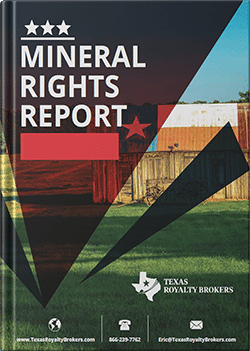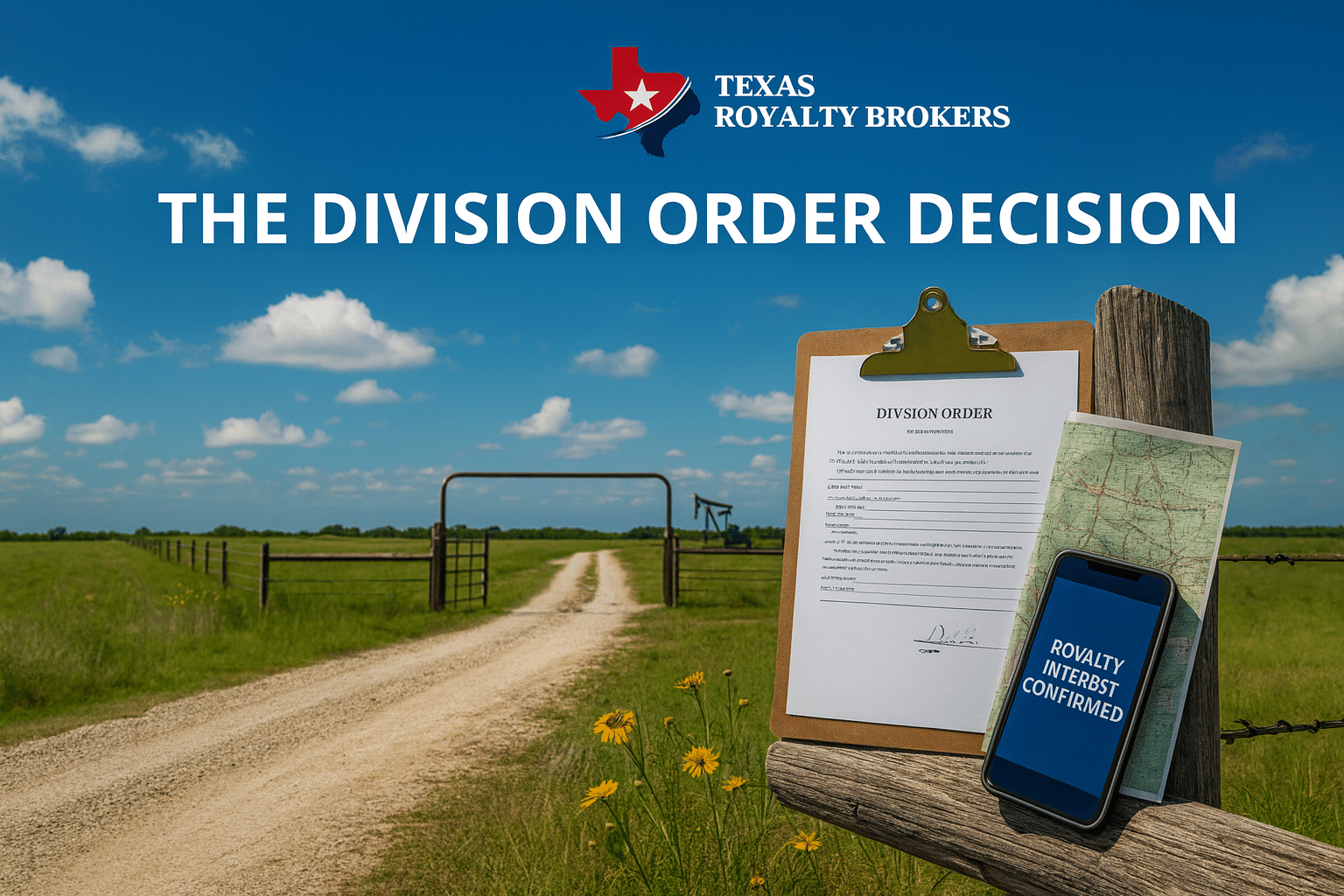Why Texas Royalty Brokers?
sellers
Buyers
State Specific Guides
Resources
What Is a Division Order? A Simple Guide for Mineral Owners
If you just received a division order and you’re not sure what it means, don’t worry. You’re definitely not the only one.
These documents can look confusing at first glance, especially if you’re new to owning mineral rights or this is your first producing well.
The good news is that a division order usually shows up when a well is producing and the operator is preparing to start royalty payments. That’s a big milestone. Before you sign anything, it’s important to understand what you’re looking at and make sure the details are accurate.
You should not sign your division order until you’ve read this entire article completely. There are a few important things you need to check first, and signing too quickly can lead to mistakes that are hard to fix later.
This guide is here to walk you through everything you need to know about division orders in plain language.
We’ll cover what a division order is, why you receive one, what to look out for, and help you understand if signing is the right move. We’ll even go through a real example so you can see exactly what these forms look like and how to read them.
Let’s take it one step at a time and make sure you feel confident moving forward.
What Is a Division Order?
A division order is a document sent to a mineral rights owner when a well starts producing oil or gas. It shows the owner’s share of production and outlines how much they will be paid in oil and gas royalties. Once signed, it gives the operator permission to start sending royalty payments based on the ownership interest listed in the order.
In simple terms, the division order confirms two key things:
-
You own a share of the production from a specific well
-
The operator has calculated your portion and is ready to pay you
The document will list your name, the legal description of the property, the well(s) or unit name(s), and your decimal interest in the production. That decimal might look small, but it plays a big role in how your royalty payments are calculated.
It’s important to know that a division order is not the same as a lease agreement. You signed a lease to give the operator the right to drill. The division order comes later, after the well is completed and the revenue starts coming in.
In most cases, you’ll receive a division order directly from the operator or their revenue department. They’re required to send it before paying out royalties, and they want to make sure you agree with the numbers before they start cutting checks.
It might seem like a routine form, but it’s worth taking a close look. If the information is wrong or the decimal is off, it can affect how much money you receive.
Next, we’ll look at why you receive a division order in the first place and what triggers it.
Why Do You Receive a Division Order?
If you’ve received a division order in the mail, it’s because something has changed. Either your ownership changed or new production has come online, and the operator needs to confirm your share of future royalty payments.
There are a few common reasons why this happens:
Ownership Changed – If mineral rights were sold, inherited, transferred into a trust, or updated due to a title issue, the operator needs to update their records. Once that change is reflected in their system, a new division order is sent to confirm the updated ownership and decimal interest.
You Inherited Mineral Rights – If you recently inherited mineral rights, you’ll likely receive a division order after probate is finalized and the operator has processed the change in ownership. This document is how they make sure they’re paying the correct person going forward.
A New Well Was Drilled – Even if your ownership didn’t change, a new well on your mineral acreage may trigger a new division order. That’s because each well has its own unique revenue stream and your interest might be different from one well to the next, especially in unitized or pooled acreage.
New Operator – If a new operator takes over the well, they might send out division orders to existing owners so they have their own division orders.
In simple terms, a division order is sent any time your share of production from a well changes. That change could be because:
- A new well started producing
- Your ownership changed
- The operator changed
It all comes down to making sure you get paid correctly based on your current ownership at that moment in time.
It’s also how the operator protects themselves. They are not going to send royalty checks until they have verified that their records match what you agree to. That is why they send a division order and ask you to sign it, so they have written confirmation of your ownership and decimal interest.
Next, we’ll go over how to understand what’s actually in a division order and what to look for before signing anything.
Understanding Division Orders
You receive a division order because the operator is ready to start paying royalties, and they need your confirmation that everything looks correct. It’s part of the process that happens after a well starts producing.
Here’s how it typically works:
- You sign an oil and gas lease giving an operator the right to drill.
- The operator drills a well, and hopefully, it turns out to be productive.
- Once the well is producing and selling oil or gas, the operator calculates how much each royalty owner should receive.
- Before sending any checks, the operator sends a division order to each owner, listing their share of the production.
The purpose of the division order is to confirm your ownership and how much you’re entitled to before any money changes hands. It acts as a final checkpoint for the operator and the mineral owner.
It’s also important from the operator’s perspective. By having you sign the division order, they reduce their legal risk. They’re getting your written acknowledgment that you agree with your decimal interest and that they can start paying you based on that number.
It may seem like just a formality, but it’s a critical document for both sides. And since royalty payments are often ongoing for years, getting it right at the beginning matters.
How Do I Know the Decimal Interest Is Accurate?
The decimal interest listed on your division order is one of the most important numbers on the page. It determines how much of the revenue from a well you are entitled to, and it directly affects your royalty payments going forward. If that number is wrong, it could mean you are getting paid less than you should.
So how do I know if my decimal interest is accurate?
The truth is, most mineral owners cannot verify it on their own.
We estimate that 99%+ of the mineral owners we talk to sign the division order without knowing whether it’s accurate. While uncomfortable, this is actually very normal.
Even if you know how many net mineral acres you own and remember the royalty rate in your lease, there is one critical piece of the puzzle you probably do not have: the size of the unit. Without that, you cannot double-check the math.
Still, it is helpful to understand how the decimal interest on a division order is typically calculated.
Here is a simplified version of the formula:
(Your Net Mineral Acres ÷ Gross Acres in the Unit) × Royalty Rate = Decimal Interest
For example, let’s say you own 10 net mineral acres, the unit is 100 gross acres, and your lease has a 20 percent royalty. Your decimal would be:
(10 ÷ 100) × 0.20 = 0.02
That means you would receive 2 percent of the revenue from the well.
However, you would need to know all three pieces. The net mineral acres, unit size, and royalty rate to run this calculation. Most owners do not have access to everything they need, especially when it comes to the actual unit size or how the operator structured the unit.
Even if you know how many net mineral acres you have from when you signed the lease, how do you know that number was accurate? The reality is that you don’t.
The only way to actually verify all of this information is to hire a landman to run title and confirm everything. This takes time and could run $500 to a few thousand dollars. Unless you have a large mineral rights ownership, it’s generally not worth it to run title to verify the operator is accurate.
As a mineral owner, you’re ultimately relying on the operator to calculate your decimal interest correctly on the division order.
Do You Have to Sign a Division Order?
In most states, you are not legally required to sign a division order to receive royalties. In reality, no money will be released until you do.
Operators will place your payments in suspense and hold them until they receive your signature confirming the ownership and decimal interest are correct.
This is standard practice. It protects the operator from overpaying or paying the wrong person. From their perspective, a signed division order is the green light to begin issuing royalty checks.
That is why it is so important to review the division order carefully before signing. If anything looks off, reach out to the operator or contact us for a free consultation. We can help you confirm whether your decimal interest is correct before you lock it in.
What Is Suspense?
Suspense is when the operator holds your royalty payments in a separate account until something is resolved. In most cases, it means they are waiting on a signed division order, but it can also happen due to title issues, probate, or missing paperwork.
Your money is not lost. It is just being held until the issue is cleared up. Once everything is in order, the operator will release the funds, often in a lump sum.
New Wells – The Suspense Trick
If you are getting a division order in the mail, you should know why. If you do not know why you are getting the division order, this likely means that new wells are coming online. Check your old check stubs and compare them to the division orders you received. Are there new wells you don’t recognize?
If a new well was just completed and you have not signed the division order yet, you have options! By leaving the funds in suspense, you can sell your mineral rights and let the mineral buyer collect the income. This can be a smart move if you are looking to avoid taking the royalty income yourself and want to simplify your tax situation.
If you receive division orders for new wells, this is a key decision point! This is the best time to sell mineral rights! Do not immediately sign the division order. Take a moment and consider your options.
Texas Royalty Brokers can help you time the sale correctly and make sure the buyer captures the income that was held in suspense. This will save you a fortune in mineral rights taxes.
Next, let’s look at a sample division order so you can see exactly what to expect.
The Division Order Decision
When a new well comes online, the operator will send you a division order. A division order confirms your decimal interest and instructs the operator where to send your royalty checks.
Until it is signed and returned, the operator will hold your money in suspense.
This is your decision point.
Do not rush to sign and return the division order until you have carefully considered your options. Once you sign, the operator will release the funds and start paying you monthly, which locks you into collecting royalty income. That income is taxed at ordinary income tax rates.
Before signing, think carefully about your alternatives:
-
Sign and collect royalties. The operator will release the suspense and begin paying monthly checks. Future offers from buyers will usually be lower, since they base value on decline curves and predictable cash flow rather than peak potential. You will now likely be losing about 30% of that royalty income to taxes.
-
Pause and evaluate a sale first. Many mineral owners choose to market their mineral rights for sale at the DUC or Completed stage before signing. Buyers know new royalty income is about to begin and will often pay a premium to take over. If you inherited the minerals, selling can also be more favorable from a tax perspective because it is typically treated as a capital gain with step-up basis treatment.
The division order represents a key moment of choice.
Signing means accepting ordinary income taxes and future decline in offers. Waiting to evaluate a sale first can allow you to capture peak market value and potentially better tax treatment.
Division Order Example
If you’ve never seen a division order before, this is what one looks like. You can click the button below to download an example.
In this example, the division order was issued because mineral ownership changed from one party to another. That’s one of the most common reasons these forms are sent out. It usually happens after a sale, inheritance, or transfer into a trust.
If you received a division order unexpectedly, there is a good chance it is tied to a new well. That often surprises mineral owners, especially if they were not aware that drilling had taken place on their property.
Whether it is due to a new well or a change in ownership, the division order is your confirmation that royalties are being calculated and that payment is likely around the corner. It is important to review the details carefully before signing.
Should You Sell Your Mineral Rights Before Signing a Division Order?
Before you sign your division order, it is worth asking yourself an important question. Is now the right time to sell your oil and gas royalties?
Getting a division order means your mineral rights are producing or are about to start producing. That is a major milestone, and for many mineral owners, it is the first time the asset starts generating real value.
It also happens to be one of the best times to consider selling.
When your minerals are producing, buyers can see exactly what the well is making, what your decimal interest is, and what kind of income the asset is generating. That transparency makes your property much more valuable compared to a non-producing interest. With real numbers to evaluate, serious buyers compete harder, and that drives up your sale price.
If your royalties are still in suspense and you have not signed the division order yet, you may have an additional advantage. You could sell before any income hits your account, allowing the buyer to collect the payments. This can help you avoid the tax burden of receiving royalty income and keep the process simpler. The buyer signs the division order and takes over from there.
Selling is not the right choice for everyone. However, for many mineral owners, this is the moment when the property is easiest to sell and brings in the highest offers.
If you are even thinking about selling, reach out before you sign. Texas Royalty Brokers can help you understand the value of your minerals and whether now is the right time to sell.
How Texas Royalty Brokers Can Help
If you’ve received a division order, there is a lot to consider. From confirming your decimal interest to deciding whether now is the right time to sell, it can feel overwhelming. This is especially true if it is your first time dealing with mineral rights.
That is where we come in.
At Texas Royalty Brokers, we specialize in helping mineral owners just like you. Whether you need help reviewing your division order, verifying ownership, or understanding your options before you sign, we offer clear guidance and honest advice.
If you decide to sell, we do not just list your minerals and hope for the best. We market your property to a wide network of serious, qualified buyers who compete to give you the best price. We handle the process from start to finish and work to make sure you get top value with the least amount of hassle.
Whether you purchased land with mineral rights or inherited mineral rights, you want to maximize the value.
Contact us for a free consultation. We are here to help you make smart, informed decisions and ensure you are not leaving money on the table.






